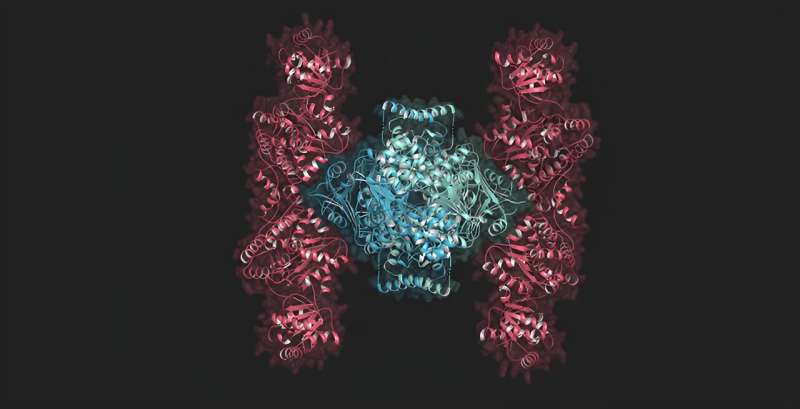This article has been reviewed according to Science X's editorial process and policies. Editors have highlighted the following attributes while ensuring the content's credibility:
fact-checked
peer-reviewed publication
trusted source
proofread
Study reveals unexpected strategy in competition between bacteria and viruses

If you've seen the original Star Wars movie, you might wonder whether the iconic Tie fighter was modeled after the Gabija protein complex, a bacterial defense system.
From a certain angle, they appear to share the same distinctive shape: a deadly center protected by two wings. They also share a purpose: defend the realm.
But the structure of Gabija was revealed only recently. It was solved for the first time by virology doctoral candidate Sadie Antine in the lab of Philip Kranzusch, professor of microbiology at Harvard Medical School and Dana-Farber Cancer Institute. The research is published in Nature.
Understanding how Gabija and other elements of bacterial defense systems look and work—along with the mechanisms that viruses known as phages use to overcome these defenses and infect bacteria—promises to illuminate broader aspects of immunity, including human immunity and immune responses to cancer.
Already, the team has revealed an unexpected strategy that phages might use to neutralize Gabija in the evolutionary arms race between bacteria and phages.
"This is the importance of basic science," said Kranzusch, senior author of the paper. "We're learning how cells defend against infection."
Snapshot of the protein complex
Gabija is one of hundreds of defense systems found in bacteria. It is present in about 15% of all bacteria whose genes have been sequenced.
"It's one of the most prevalent bacterial defense systems," said Antine, who is first author of the study. "Yet very little was known about how it works or how viruses that infect bacteria can evade the system."
To learn what Gabija looks like when it is a fully formed molecular machine, also known as a protein complex, Antine used a technique called X-ray crystallography. The process involves coaxing the bacteria to make the protein complex, crystallizing the complex so that it is immobile, and then scattering X-rays off it to get a precise, atomic-level 3D snapshot of the structure.
Gabija, she learned, is a very large complex. It is about one-quarter the size of the ribosome, which is a huge molecular machine that performs the incredible task of using information from RNA to make proteins.
Antine also learned that Gabija is formed using the instructions from just two genes, GajA and GajB. GajA forms proteins that connect in groups of four to form the center of the structure. GajB forms proteins that connect to form the outer winglike portions of the structure.
"It's an arrangement that you never would have guessed until you did the experiments," said Kranzusch.
It isn't yet clear how this large complex recognizes and defeats the phage. But Antine and Kranzusch suspect that the complex recognizes a specific structure formed by phage DNA and then degrades it.
"Gabija has exquisitely evolved to hunt and destroy a very particular target," said Kranzusch.
A phage's evasive web
Antine and Kranzusch collaborated with a team at the Weizmann Institute in Rehovot, Israel, to home in on Gabija as a defense system of interest and to identify the phage that can evade it.
With this knowledge, Antine took a gene known to make the phage evasive and introduced it into bacteria that create Gabija to learn more about those evasion tactics.
Antine wanted to look at Gabija as it interacted with the phage protein. To do this, she used cryo-electron microscopy (cryo-EM), which involves super-cooling the complex and using a beam of electrons to create a 3D image of the system.
"With crystallography we see a snapshot of the protein complex in a rigid state," said Antine. "But with cryo-EM, it is possible to analyze flexible complexes, and you can see how the interaction has played out."
A typical evasive move would be for the phage to alter the bit of DNA that Gabija recognizes so Gabija doesn't notice it. But the phage doesn't do that, suggesting that the DNA Gabija recognizes is essential for the phage to survive.
Another common tactic would be for the phage to evolve a bit of DNA that encodes a small protein that jams part of Gabija's essential machinery. But Antine didn't see that either.
Rather, she found that the phage evolved DNA that encodes a very large protein that surrounds Gabija and inactivates it.
"The protein forms this huge web around the entire outside of the complex," said Kranzusch. "This evasion technique creates a massive complex. It was a surprising result that changes the way we think about how phages interact with these defense systems."
Molecular one-upmanship
Phages are often thought of as small and simple, but Kranzusch has found that that's not always true. The phages he and Antine are studying are large, with DNA that holds hundreds of genes.
Phages are also considered entities rather than living organisms because they require a host cell to replicate. Yet they actively evolve and change under pressure from defense systems like Gabija.
"They are complex and can evolve and adapt with their host. They shape evolution," said Kranzusch.
For next steps, Antine will dive into the precise mechanisms Gabija uses to defeat phages. These mechanisms are the result each side finding new ways to defeat the other. The same kind of one-upmanship goes on in cancer, as tumor cells find increasingly clever ways to evade the immune system and cancer treatments.
"There are parallels between immunity in human cells and in bacteria," says Antine. "We're interested in the diversity, the many ways that immune systems combat something that is actively evolving against it."
More information: Sadie P. Antine et al, Structural basis of Gabija anti-phage defence and viral immune evasion, Nature (2023). DOI: 10.1038/s41586-023-06855-2
Journal information: Nature
Provided by Harvard Medical School





















